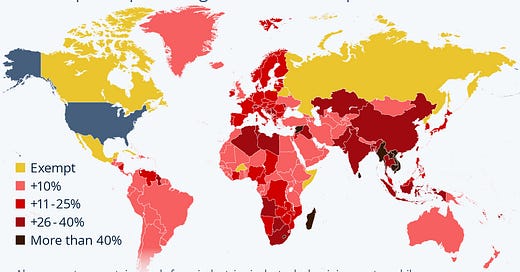Undeniably we live in a new economic era ruled by protectionism and trade wars. While I don't disagree with tariffs in principle, I actually find it a good idea if a developing country targets them correctly to increase productivity in a specific area of their manufacturing sector, as mentioned in the previous article. However, I have to admit the new US tariffs are a little bit perplexing. It is a tax to everyone and everything, creating confusion and global economic chaos.
Let’s be honest, some of the tariffs don't make economic sense. Madagascar has to face a tariff of 47%, one of the poorest countries in the world. With a GDP per head just above $500, Madagascar is not a country able to afford expensive US products, the backbone of the economy is agriculture and the country is the largest exporter of vanilla. It is unlikely that Madagascar will be able to reach a trade deal with the US that could increase imports from US to Madagascar so the tariffs can fall. As a result we are going to see the prices of vanilla increasing from the next few days. The other economic concern is whether these tariffs will support the US economy, as the US doesn't produce vanilla, so there is not any economic benefit in US production.
Madagascar is not the only example, high tariffs have been applied to countries that in general cannot afford to import from the US. Lesotho, another of the poorest countries in the world, has a main industry of textiles and exports to US designer clothes like Levi’s jeans is facing 50% of tariffs. That will not only affect the textile industry in the country but also will have a devastating impact on the country’s macroeconomic perspectives.
But the Asian countries face some of the highest tariffs. Cambodia has Asia’s highest tariff rate of 49% announced on Wednesday. The garment industry in Bangladesh will be hit hard by a 37% tariff rate; Sri Lanka, which was bailed out by the International Monetary Fund 2 years ago is facing new tariffs of 44%. The list is long, with countries that need humanitarian assistance, face natural disasters or wars have to deal with economic wars.
This is a double hit on the poorest economies, they have to face the new tariffs as well the cut of US and UK development assistance. Undeniably the consequence will be to deepen the inequalities in the world, with the poorest countries suffering in this new global economic reality.
So is the US trying to punish the poor countries, while rewarding rich countries like the UK with lower tariffs? The answer is no, at least not specifically: the formula on establishing the tariffs is very simple maths. Take the trade deficit for the US in goods with a particular country, divide that by the total goods imports from that country and then divide that number by two.
A trade deficit occurs when a country buys (imports) more physical products from other countries than it sells (exports) to them. So the poor countries like Madagascar that don’t have the wealth to import US products suffer with higher tariffs, despite that the well-being of the people in this country depend on the exports. While the UK imports almost as many goods, exports to the US get a lower tariff of 10%, but the UK has the economic and political power to change these tariffs to 0.
Below is an explanation on how the US calculated the 20% tariffs to the EU, focusing on the formula mentioned above and created by the BBC.
But the poorest countries will not be the only ones hit hard by the tariffs, the poorest 20% of Americans will see their incomes getting squeezed. Firstly they will have to face higher prices. Major US department stores like Target and Walmart, where Americans often turn for affordable clothing, will have to increase the prices of clothing as they source their products from Vietnam, China and Bangladesh, which face tariffs over 30%. Shoes and trainers will see their prices increased too. Americans will be left with no alternative; if you already buy your clothes from the cheapest store, there is no alternative for you when the prices will go higher.
Coffee, which is only imported into the US rather than also being produced there, will see its price being increased too, as the main importers of coffee in the US (Brazil and Colombia) are subject to the baseline 10% tariffs that the US imposed. The lowest 20% income earners in the US spend almost a third of their income on food. The price of food is expected to increase with the tariffs, but while the rich have the option to switch from more expensive products to cheaper ones, the poorest are left with no substitute. This is a situation that will expand the food inequalities in the US.
So, the tariffs will hit the poorest Americans, as well as poorer countries worldwide, and if the scenarios for a global recession will become true, they have to face an even more bumpy road. While any potential benefit of increasing productivity and improving manufacturing in the US will come in the long term, the poorest Americans may have to wait a long time to see the benefits from it.






I'm so glad I found your substack!Wonderfully explained
I don't follow your logic. Say a Madagascar. All they have to do is create parity with U.S. tariffs. Done. What is the big deal? As you say, we don't export what they do, so no harm to them.
The intent here is reduction / removal of tariffs across the board. A blanket approach. Some will "make sense" more than others, but that is irrelevant.